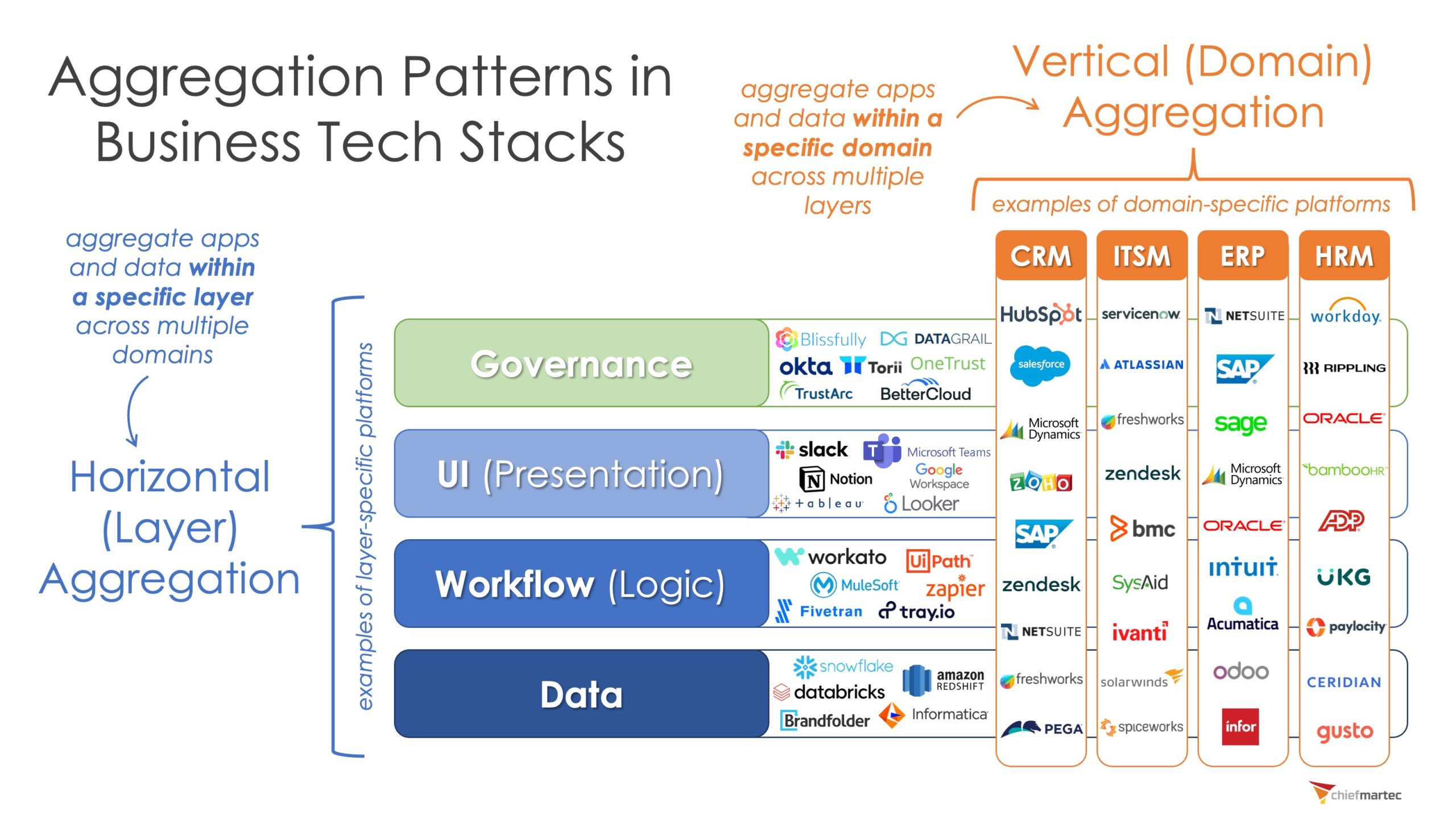Matrixed Tech Stacks with Both Horizontal and Vertical Aggregation Platforms

Last calendar year, I wrote about a sample of aggregation platforms escalating in martech stacks. The two critical characteristics of an aggregation system:
- It centralizes a cross-departmental capability (e.g., a cloud knowledge warehouse).
- It grows in price as you join much more applications in your stack to it.
That second place is significant, and not only for the clear network outcomes. To me, this activated — or was induced by — the recognition that tech stacks are expanding in variety, not consolidating into a handful of mega-applications. Instead of futilely battling The Good Application Explosion, aggregation platforms embrace it. They assistance organizations manage, harness, and govern it.
But I was genuinely only speaking about aggregation platforms at just one of the four levels of facts, workflow, UI, or governance. In thinking much more about this, I realized that these ended up only horizontal aggregation platforms. They are aggregating in that layer across lots of various departments or domains within just the group, from product sales and finance to engineering and human methods. But just within just their layer.
Having said that, we also see aggregation platforms inside of a certain department or domain. For instance, a CRM platform for marketing, income, and provider. Or an ERP system for finance and functions. These are vertical aggregation platforms. They collectively aggregate knowledge, workflow, UI, and governance services all in just their platform. But typically just in that area. You’re in all probability not utilizing your CRM to take care of to your ongoing integration and deployment pipeline.
Vertical aggregation platforms can normally be regarded serving as the “home base” application for a individual office or staff. Most key promoting platforms above the previous couple of decades in shape this design.
What is interesting is the realization that most businesses now have equally horizontal and vertical aggregation platforms inside their stack. And even though the character of any aggregation platform is to turn out to be the “one” middle of gravity within its layer or domain — ideally, there’s only a single one signal-on (SSO) provider in your stack, and only a single CRM — horizontal and vertical aggregation platforms peacefully co-exist. They may well compete in some overlaps, but they mostly enhance just about every other, specifically when they are built-in jointly.
This is a “matrixed” tech stack, where teams are frequently leveraging a mix of vertical and horizontal platforms in their day-to-day function.

It reminds me of The Spotify Design for huge-scale agile program growth. All of the item people performing in a unique place (area) are aspect of a tribe. Unique tribes concentrate on diverse places of the product. But inside every tribe, there are unique specialists, these types of as UX designers. A guild is formed from all people unique professionals working throughout lots of tribes.
Likewise, we can feel of the departments and domains served by a vertical aggregation system as all belonging to a respective “tribe.” The HR tribe. The IT enable desk tribe. The advertising tribe. In the meantime, everybody in individuals diverse departmental tribes who is centered on details management may also be a part of a details layer “guild.”
As a internet marketing ops individual, my tribe is advertising and marketing. A CRM system and/or a marketing automation system is my vertical aggregation system. But when it arrives to knowledge, I may possibly take part in a guild for info warehousing and analytics that spans several departments. Within just that guild, I’ll rely on horizontal aggregation platforms for info warehousing, facts pipelining, metadata administration, and business-broad small business analytics.

Vertical aggregation platforms do the job ideal when they are adopted by all the buyers in a presented division or area (e.g., marketing). Seat-based pricing is the dominant product.
They mixture by integrating with all of the other preferred apps utilized in that area. So for advertising, this contains integrating applications for occasion advertising, online promotion, content-generation equipment, affiliate management, and so forth. It’s frequently labeled the “system of record” and/or the “system of engagement” for that area.
If the area is a customer-facing 1 — these kinds of as marketing and advertising, income, purchaser provider, electronic item, ecommerce, etc. — vertical aggregation platforms in the domain typically provide experiences directly to buyers. For instance, an aggregation platform in the customer aid domain will very likely render the interface for customers to file aid tickets, verify a know-how-foundation, and have interaction with customer provider agents.
Horizontal aggregation platforms, nevertheless, do the job most effective when they are adopted by all the departments across a organization — but are not essentially instantly utilised by everybody in every single of those departments. The exceptions are inclined to be horizontal aggregation platforms at the UI/UX layer, this kind of as collaborative communications platforms like Slack or Microsoft Groups, that function ideal when everyone in the enterprise takes advantage of them.
In my expertise, there tends to be additional API-primarily based exercise with horizontal platforms in the other levels. Their pretty character is to coordinate through integration across numerous unique vertical platforms. Their human UI is ordinarily customized to experts who operate the “ops” for that distinct cross-org functionality. For occasion, a cloud details warehouse platform could ingest information from and deliver information to each major area all over the corporation. But it’s generally only information ops men and women who are interacting with the warehouse’s UI right.
Working internally, horizontal platforms are fewer probably to immediately serve purchaser-facing experiences. But they typically ability them additional at the rear of-the-scenes.
Even though some horizontal platforms use seat-centered pricing, primarily at the UI layer (e.g., Slack), it is not unusual to see usage-based pricing in the other horizontal layers. In the information layer, how a lot knowledge are you functioning with? In the workflow layer, how many automations are you functioning? In the governance layer, how many applications are you handling and monitoring?
What about the overlaps amongst horizontal and vertical platforms?
In concept, it may possibly be great to have no overlapping performance amongst merchandise in your stack. Reality is really much away from that although. In the boundaryless, hyperconnected electronic universe, the swim lanes for distinctive software items and categories are very fluid. The place they overlap, you typically conclusion up with extra than a single way in which you can put into action anything.
The downside of this intermingling amongst vertical and horizontal platforms is increased complexity in your stack and problems with governance (visibility, checking, guardrails) break up throughout numerous proportions.
The upside, even so, is bigger protection of capabilities (the union of the Venn diagram of use conditions above) and higher adaptability and adaptability in your solutions for resolving a certain issue with overlapping capabilities. This optionality also has the advantage of hedging your interactions with vendors by balancing concentration chance. Possessing solid vertical and horizontal platforms both of those in your stack will help keep them just about every in check out.
Superior ops leaders — internet marketing ops, revenue ops, rev ops, organization ops, finance ops, data ops, and fairly substantially each individual other Large Ops specialization — can mitigate the downsides of a matrixed tech stack although extracting the most benefit from it.







